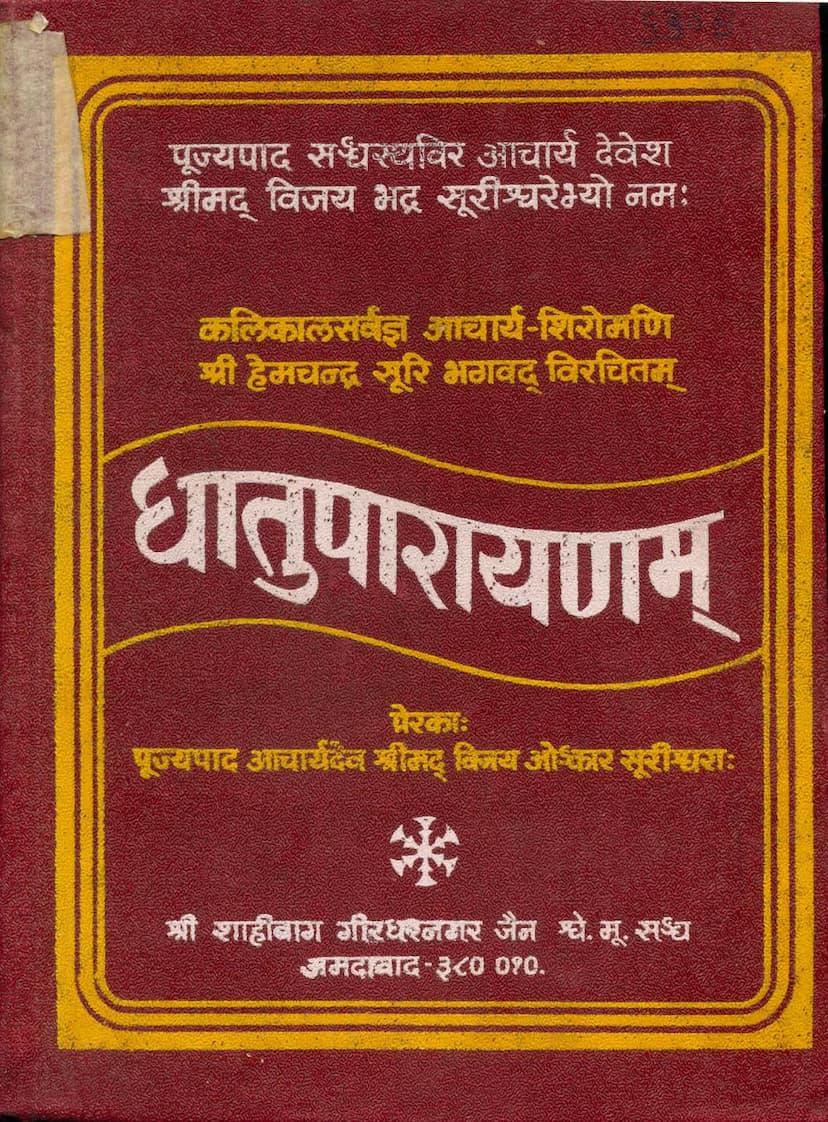Dhatuparayanam
Added to library: September 1, 2025

Summary
This is a comprehensive summary of the Jain text Dhatuparayanam by Acharya Hemachandrasuri, published by Shri Shahibag Girdharnagar Jain Shwetambar Murti Pujak Sangh, Ahmedabad.
Book Title: Dhatuparayanam Author: Acharya Hemachandrasuri Publisher: Shri Shahibag Girdharnagar Jain Shwetambar Murti Pujak Sangh, Ahmedabad. Catalog Link: https://jainqq.org/explore/004315/1
Overview:
Dhatuparayanam is a detailed commentary by the renowned Jain scholar Acharya Hemachandrasuri on the Dhatupatha (a list of Sanskrit verb roots). This work is considered a crucial supplement to his comprehensive grammar, Siddha-Hema-Shabd-Anushasana. The text aims to provide a systematic explanation of Sanskrit verb roots, their various forms, and the derivation of approximately six thousand words from them.
Key Aspects of the Text:
-
Author and Lineage: The book is attributed to the great Kālīkālasarvajña Ācārya Śrī Hemachandrasūri Mahārāja, a luminary in Jain and Sanskrit literature. The publication is dedicated to Pujyapada Acharya Devesh Shrimad Vijay Bhadra Surishvarebhyo Namah and inspired by Pujyapada Acharya Deva Shrimad Vijay Onkar Surishwarji. The editor, Muni Munichandra Vijaya, is a disciple of Pujyapada Acharya Bhagavant Shrimad Vijay Bhadra Surishwarji.
-
Publisher and Context: Published by Shri Shahibag Girdharnagar Jain Shwetambar Murti Pujak Sangh, Ahmedabad, this work emphasizes the importance of preserving and making accessible ancient Jain literature. The publisher expresses a desire for all Sangh (organizations) to publish such ancient texts to bring forth valuable literature.
-
Content and Methodology:
- Focus on Dhatupatha: The book is a detailed explanation (vivarana) of the Dhatupatha, one of the five parts of Sanskrit grammar.
- Explanation of Verb Roots: It covers the various forms of verb roots (dhatus) and elaborates on approximately six thousand derived words.
- Systematic Approach: The text is organized systematically, first presenting parasmaipadī (active voice) roots, then ātmanepadi (middle voice) roots, followed by ubhayapadī (both active and middle voice) roots. Within these categories, it primarily follows a vowel-ending (svarānta) order, then consonant-ending (vyanjanānta) roots. Deviations from this order are often explained by the author's reasoning, such as semantic similarity or sequential flow.
- Grammatical Analysis: For each root, the text provides its meaning, synonyms where necessary for clarity, and the rules from the Siddha-Hema-Shabd-Anushasana grammar that govern its usage and derivation. It also details the formation of kṛdanta (derived nouns and adjectives formed with kṛt suffixes) and uṇādi (words derived from uṇādi roots).
- Addressing Discrepancies: The text acknowledges and addresses the various interpretations and differing Dhatupāṭhas found in other grammatical traditions, such as Pāṇini, Kaśakr̥tsna, Kātantra, etc. Hemachandracharya's work is presented as a synthesis and refinement of these traditions.
- Attribution of Opinions: Where different grammatical schools or authors have differing views, Hemachandracharya mentions them, often using phrases like "eke" (some), "anye" (others), or "kechit" (a few), and sometimes citing specific authors. The appendices provide further details on these unidentified authors.
-
Importance and Utility:
- Mastery of Sanskrit: The study of this book is essential for gaining mastery over the Sanskrit language.
- Understanding Agamas: Through knowledge of Sanskrit and Prakrit grammar, one can understand the teachings embedded in the Agamas (Jain scriptures) and other works by maharsis (great sages).
- Spiritual Progress: The ultimate aim of studying these texts is to absorb the divine words of the Tirthankaras and progress on the path to Moksha (liberation).
- Accessibility: The publication of this rare and useful text makes it accessible to scholars and students, fulfilling a scholarly duty as described in scriptural texts ('Pustak Drishti').
-
Inspiration and Acknowledgements: The publication is inspired by Acharya Bhagavant Shrimad Vijay Karasurishwarji Maharaja and his successors, who have significantly contributed to the propagation of the Jain faith. The editor expresses gratitude to Pujyapada Virya Muniraj Shri Jambuvijayji Maharaj Saheb for guidance and acknowledges the libraries that provided manuscripts and printed copies, including the Shri Hemachandra Acharya Jain Gyan Mandir-Patana, Shri Sanvegi Upashray, Hajapatelni Piol-Ahmedabad, and Shri Vijay Gachchha Gyan Bhandar-Radhanpur. The printing was satisfactorily done by Kantilal D. Shah of Bharat Printers, Palitana.
-
Biographical Information: The text includes brief biographical details of Acharya Bhagavant Shrimad Vijay Bhadra Surishwarji Maharaja (birth: V.S. 1930, Radhanpur; initiation: V.S. 1958, Radhanpur; Acharya title: V.S. 1989, Radhanpur; demise: V.S. 2033, Junadisa). It also mentions Acharya Bhagavant Shrimad Vijay Karasurishwarji Maharaja (birth: V.S. 1979, Zinzuvada; initiation: V.S. 1990, Zinzuvada; Panyas padh: V.S. 2006, Radhanpur; Acharya padh: V.S. 2010, Mehsana).
-
Historical Context: The text mentions the earlier publication of a similar work edited by a German scholar, Joh. Kirst, in 1899, which is now rare and in a dilapidated state. This highlights the effort made by the current publishers to bring a valuable, ancient text to the public.
Structure and Appendices: The text is extensive and includes various appendices, such as:
- A list of dictionaries used in the compilation (Sampadanopayukta Granth Soochi).
- A corrigendum (Shuddhipatrakam).
- An index of roots (Dhatusoochi).
- A list of words (Shabd Soochi).
- A list of quoted authors (Uddhṛt Granthkar Soochi).
- A list of quoted texts (Uddharaṇ Soochi).
- A collection of differing opinions (Matāntara Sachi).
- Special notes (Vishesh Tippani).
- A list of contents (Vishay-Anukramani).
Conclusion:
Dhatuparayanam by Acharya Hemachandrasuri, as presented in this edition, is a monumental work in Sanskrit and Jain grammar. It offers a profound and detailed exploration of Sanskrit verb roots, vital for understanding the nuances of the language and, by extension, the profound philosophical and spiritual teachings within the Jain tradition. The publication represents a significant effort to preserve and disseminate this invaluable ancient knowledge.